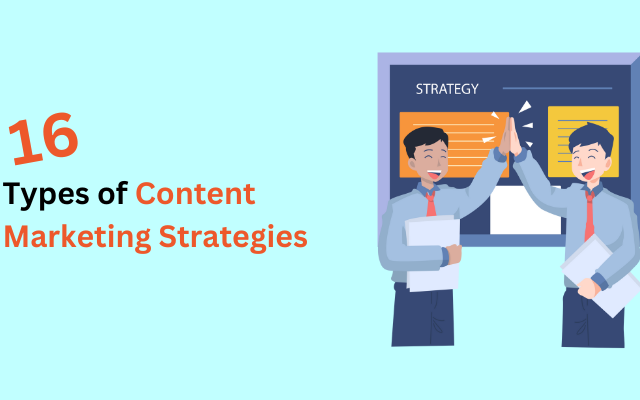Be it the online gift store love or the electrical service you trust the most for home repairs, every platform uses quality content to drive more traffic. And ultimately, to earn more leads.
So, crafting content that appeals to your customers is crucial to expanding your reach. We’ll explain all about how that’s done through this comprehensive guide on the 16 best types of content to use as part of your content marketing strategy.
So, let’s begin!
The Need to Use Different Formats of Content Marketing
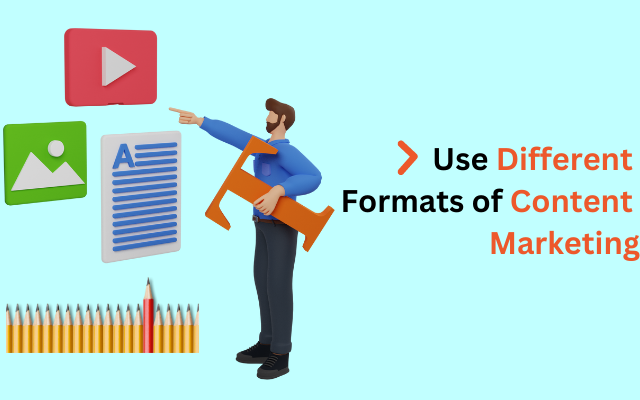
When we normally say content type, it refers to the format of the media file you’re publishing somewhere. It might be a blog, an eBook, an email newsletter, a whitepaper, an infographic etc.
Now, it’s important for the format of content marketing format used by any business to match their goals, offerings, audience demographics, and budget. You may sometimes end up choosing a wrong content format that’s either irrelevant to your needs or requires stretching your budget. Side by side, using merely a few formats might cause boredom and deprive you from experimenting with other formats.
That’s why it’s best to utilize a combination of several content formats to enhance the effectiveness of the content marketing campaign. This can help you stay ahead of competitors and boost your ROI for marketing. In a later section, we’ll also discuss how you can monitor the impact of a content marketing campaign with the help of marketing KPIs.
The Most Profitable Types of Content Marketing to Use in 2024
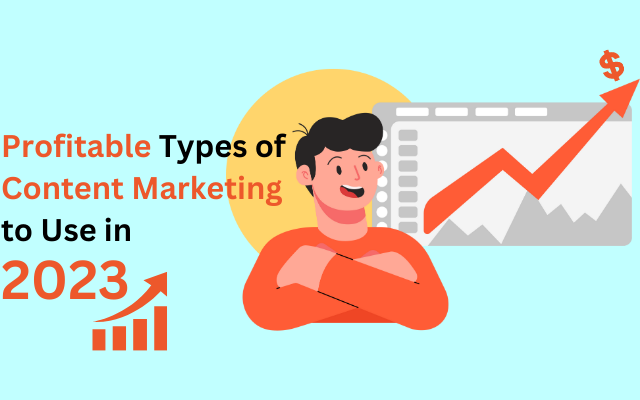
1. Blog Posts
Blogs are perhaps the most abundant form of web content. These are conversational write-ups on either a broad or specific topic.
Marketers mostly dedicate a separate section of the website to blogs, or otherwise, upload their blogs on specialized blogging sites. The best part about this content format is its versatility- you get to explore various writing styles and have the freedom to choose any topic.
Just figure out the ones that would suit your content marketing goals, and you’re all set. The more successful blogs you’re able to create, the more conversions and traffic you’ll gain in the long term. And that too, without any massive recurring costs!
These long-format content pieces let you focus on target keywords effectively and provide vast information to search bots about the content. And ultimately, the bots can yield more effective answers to search queries.
Here are a few key points to remember while using blogs to achieve your content marketing goals:
a) Include the latest information
It’s a must to update your blog posts on a regular basis- it will not only draw fresh traffic to your blog but may also help convert them into leads or potential customers.
b) Elaborate wherever needed
The more effectively you elaborate on a point in the blog, the easier will it be for a search engine to evaluate the text and rank the blog accordingly. *
c) Keep in mind the average length of a blog
As per the latest content marketing data, the average blog post is 1500 to 2500-word long, and generally includes ample evidence, facts, and substance on any topic. And that’s what search engines look for in any content piece. Ultimately, this makes long-form content stand out and rank higher than shorter formats like social media posts.
d) Optimize your blogs for the loading speed
Avoid overloading your blogs with images and arrange the text in a way that the page isn’t cluttered. Other ways to improve the loading speed are to reduce the redirects on the site, enable browser caching, and ‘minify’ the JavaScript, HTML, and CSS for the site.
However, you may skip these steps to directly switch to a performance-optimized solution for hosting the site, which includes page speed alteration.
e) Use the right marketing channels for your blogs
For instance, you may choose to put forth your blog through either social media or automated emails based on the engagement they earn.
f) Add links to high-authority sites
Including authority links in your blog can fetch more targeted traffic for your site and earn better industry credibility as well. And these are sure to reflect in the SERP rankings of the site.
g) Skim the content effectively
Make sure to add an appropriate number of headings as that helps search engines understand and read the text more effectively. Plus, a skimmable blog can help readers understand its coverage, importance, and usability in solving an issue.
2. Customer Testimonials & Reviews
While figures do tell you about business performance to an extent, the feedback from your customers reflects your ultimate success. In a review or testimonial, customers’ opinions are the center point. That’s why a positive comment by an existing customer provides you with a word-of-mouth advantage. On the other hand, testimonials are recommendations of a service or product, vouching for the value it gave to the user.
Do note that visitors to your page will look for credibility. And that’s best achieved through testimonials or reviews, rather than any form of paid marketing.
Review and testimonials are generally brief, so you can insert them in video captions, landing pages, blogs, or images as needed. For instance, marketing agencies might showcase comments of pleased clients on their landing pages.
But how much can this form of content really achieve? Recent surveys revealed that 93% of consumers say online customer reviews affect their choices while shopping. And since the reviews are customer generated, you incur zero costs!
3. How-Tos and Guides
In effect, these are quick blogposts where businesses discuss specific topics with customers to develop their knowledge in that area. Such content pieces come with helpful suggestions and tips on the topic
How-tos and guides assist people with achieving specific sales goals. It’s worth noting here that the person viewing a guide or how-to article is already interested in the topic. So, you have the opportunity to explain its usefulness using a real-life instance involving a prospect!
Approach how-to guides by identifying common problems related to your business expertise. You’ll then need to address those problems with solutions- discuss all the steps needed and do summarize the process before you conclude.
Here are some other factors to keep in mind:
- Choose a topic relating to your daily business schedule.
- It may be specific to your industry or have a general appeal.
- Explain the steps thoroughly.
- Provide videos, pictures, and diagram
With all done right, how-tos and guides can provide a significant boost to your sales outreach within months.
4. Case Studies
Another user-oriented form of content marketing is a case study. It lets you address a specific problem that your customers are likely to face after a purchase. To prepare a case study, you can use the knowledge and resources the company already has. But how do you go about it?
Your business can demonstrate the expertise that’s already been utilized to help other entities. This is an opportunity to ensure your prospects understand what the business can do and how it can fulfill the task.
Just provide a real-life scenario to your audience which demonstrates a user utilizing your service or product to solve a specific issue. This allows consumers to witness the entire purchase journey and visualize how the service or product works. Importantly, this helps reduce the perceived buying risk, especially for expensive services or products.
Do note that the primary goal is to show the target audience why your business is the best at solving a problem.
5. Email Marketing
For the marketers of today, email marketing is no less than a staple. After all, it’s one of the fastest and most flexible methods to reach a very targeted group of potential customers.
People still do read emails despite the rapidly evolving digital marketing scenario. So, it’s a great tool to keep in touch with customers and subscribers and build a long-lasting relationship. A 2021 study revealed that emails earn an ROI of $36 for every dollar spent on them.
Let’s look at some crucial factors to keep in mind while crafting an intelligent, conversion-worthy email marketing copy:
- Make it short
- Make it scannable
- Add a compelling headline
- Don’t be too promotional
If you’re using email marketing for the first time, we’d recommend taking inspiration from the content that worked for you in the past. For instance, you can choose to reach the audience with content marketing strategies that clicked for Quora, Reddit, and Buzzsumo.
Remember that email marketing requires you to contact people on a regular basis at each stage of the business funnel. In special cases such as when a lead is hesitant to proceed or it’s a customer’s birthday, you’ll need to handle things more tactfully.
Use limited-time offers or birthday messages to maintain the brand image. Additionally, abandoned cart messages can urge people to complete a purchase.
6. Listicles
Any information you present as a list is easier to understand and utilize. That’s why listicles have turned so popular nowadays with content marketing platforms such as Buzzfeed. Every item you choose for your list would include either a few sentences or paragraphs to elaborate on each list item.
These articles with compelling headlines make the readers learn something new each time or feel entertained in a unique manner. Plus, the use of multiple sub-heads (for each list item) makes the write-up easy to scan and imbibe.
Listicles can even make denser and drier articles easier to read. Remember that the use of a headline with a number is likely to fetch more clicks compared to standard headlines.
7. eBooks
An electronic journal on a specific topic, often called an eBook, is created to entertain readers and provide them with vital information simultaneously. Plus, it provides businesses with the scope to engage in impactful yet subtle content marketing.
An eBook that has engrossing information will arouse a keen interest in a subject. Readers would then seriously consider suggestions to go for relevant services or products.
Do note that people put a high value on an e-book when it first emerges in the market. And when the perceived value in a content piece is high, it implies readers will spend more on acquiring and applying the content besides sharing it.
For instance, you can write an exhaustive e-book on website layout and recommend your web design tool as an effective solution at specific points in the journal.
eBooks do hold a little more value when compared to blog posts, but not all of them turn out to be worthy of consumer attention. So, be careful while deciding what to put into an e-book- it should be interesting enough to fetch you loads of traffic and shares.
- Have these point in mind before you begin work on your next eBook:
- Don’t neglect the design aspect- good graphics, color usage, and formatting are a must to grab the reader’s attention.
- Create an HTML and a PDF version of the eBook. An HTML version lets you embed audio, video, and other resources effectively.
- A catchy title wins anytime- so don’t hurry with the title to ensure readers feel drawn towards what the eBook holds.
8. User-Generated Content
Original content created by existing customers is another form that provides authenticity to your content marketing campaigns. Such brand-specific content is published on media channels by third-party entities, which is why it doesn’t need too much investment by the business.
User-generated content ranges from selfies tagging previous users to videos featuring people using the product. As such, this content type provides the much-yearned social proof and word-of-mouth essential for driving business growth. Do note that user-generated content can be sourced from different groups of customers or stakeholders based on how well you’ve been able to engage with them. For instance, an unboxing video or fun-filled post on Instagram can help attract several potential customers. It might also come from brand loyalists who’re enthusiastic about the business and can be approached for UGC content describing their experience. In addition, there are UGC creators who emulate original UGCs to create sponsored content that’s apparently authentic.
9. Posts on Social Media
Considering that social media channels are used by 5.44 billion people worldwide, it isn’t surprising that most businesses invest heavily in this medium.
It lets you project quality content through multiple platforms including Instagram, Facebook, Snapchat, LinkedIn, and Pinterest. And for each of them, you can create and share many different types of content, such as short marketing copies, pre-recorded videos, live sessions, stories, and photos. Presenting attractive content in a concise form is more convenient than ever nowadays, thanks to the above-mentioned social media channels. Such content marketing platforms have provided businesses with advanced options for targeting their audience and analytical data on viewer feedback.
When viewers spot a useful and engaging piece of content, they proceed to share it with their peers on a platform and the cycle continues. This can ultimately help expand your business reach exponentially. To reap the best results from social media marketing, you’ll need to identify the best platforms your audience are using and speak to them with your content. Also, make sure to engage with social media influencers as they can make your content more impactful wherever needed.
10. Webinars
If you just came up with a new idea or concept to educate potential customers, go ahead and plan a webinar to market the same.
With such content marketing services, you can interact with the audience in real time and create a strong bonding with them. In addition to educating potential and existing customers, this content format will help you attract leads and even establish authority in your industry.
You can even choose to add an interview-like element to the webinar so that users get the feel of a podcast. Do note that webinars are at least 30 minutes long since they come with highly educational content.
11. Lead Magnets
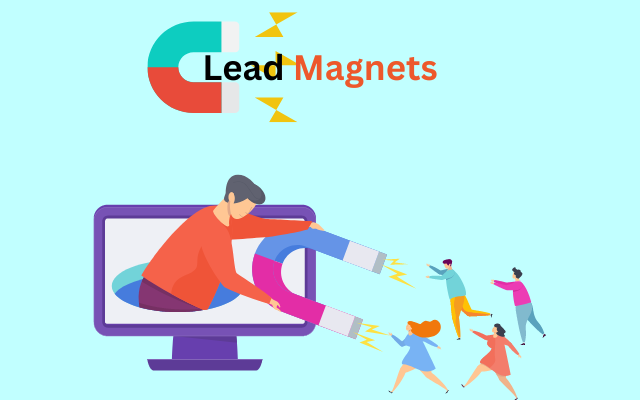
Lead magnet is the term used for free resources that can earn clicks from potential buyers in your niche. These may make visitors want to subscribe to the mailing list and eventually turn into paying buyers. Thus, lead magnets play an important role in promoting a business and generating leads.
Know that a lead magnet has several forms, but usually has the following characteristics:
a) Involves zero costs
b) Has good perceived value, which can be helpful, informative, or valuable
c) Is free to deliver
Businesses might put forth lead magnets on their website in the form of a free white paper available in exchange for your name and email address. By opting for such a document, both the customers and businesses obtain something that has real value.
The email id of a potential customer would hold great value to your business as it would let them connect with the people on a personal level. Recent studies revealed that 99% of consumers go through their email daily. Moreover, people who buy email-marketed products spend 138% more compared to those who don’t.
Now, here are some tips to make your lead magnet truly marketable:
- It should help achieve your content marketing strategies quickly.
- Target a specific issue rather than something more general. Remember that customers should be clear about the benefits of the lead magnet, as that would make them likely to convert into a lead.
- Try to solve genuine customer problems.
- The lead magnet should hold high value, both perceived and actual.
- Make sure customers can access the lead magnet quickly.
- It should demonstrate your expertise or unique value to the person.
12. Visual Content
Visual content marketing encompasses various formats such as GIFs, videos, and images and is possible through multiple platforms. With a visual content format, you can engage the target audience better, grow a business, and even build emotional connections.
But do note that this type of content marketing strategy isn’t just about sharing infographics or appealing pictures. It’s also about understanding how our brain processes a visual and leveraging that idea to boost your content marketing initiatives.
It’s worth noting here that 43% of visual marketer’s struggle with creating engaging content consistently. Running out of ideas for such content is natural at a certain point, but you shouldn’t feel discouraged. Try to be more creative and look beyond mere static imagery, as that will ensure you stand out from competitors easily.
The most popular types of visual content to start creating include:
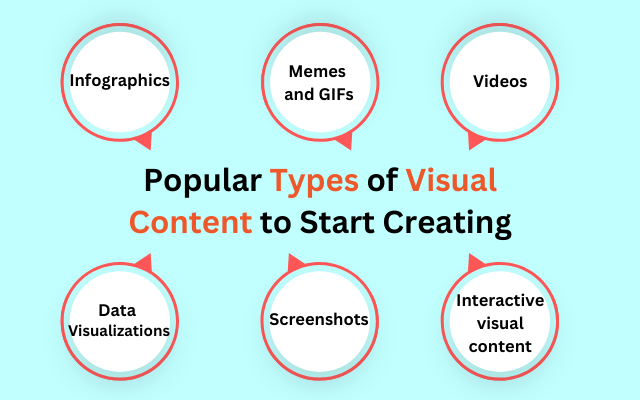
Infographics
One of the best ways to pack a lot of data within a single traffic while ensuring it doesn’t look ugly or complex.
Memes and GIFs
GIFs are a good option if you’re willing to add flashiness to the content while avoiding heavy files such as videos. On the other hand, memes are made to evoke humor and use recognizable images with funny captions for the purpose.
Videos
As per the latest data by HubSpot, 92% of marketers regard videos as a key part of their marketing strategy and gives them a positive ROI from video marketing.
So, if you’re yet to use video content marketing to your advantage, we’d strongly suggest starting now! There are plenty of types to try out – explainers, screen-sharing videos, speaker-view videos, candid’s, short films, and many more.
Data Visualizations
While including research findings and statistics in long-form content or even short marketing copies, do consider visually representing the data. Data visualization can take multiple forms and shapes like pie charts, bar graphs, area charts, line graphs, and so on.
Screenshots
Want your viewers to act on advice? Or need to make a content piece more credible? Then adding screenshots is the best idea. For instance, businesses dealing in SaaS require this form of visual content exhaustively to showcase the working mechanism of their offerings.
Interactive visual content
Rather than just using static images for your marketing activities, you could create visuals that the audience can interact with. This can be possible by creating an interactive bar graph, map, or simply a mini quiz on topics that your customers may find interesting.
13. Slide Decks
Slide decks are presentations composed of multiple screens or slides displaying some information in the form of videos, images, or text. The aim is to break down a complex discussion into simpler bits for a clear understanding.
Thus, marketers use decks to effectively explain customers as to what they would gain by investing in their product or service. You can also modify a slide deck to suit changing business needs or evolving marketing goals.
Here’s a round-up of what the audience expects to know from any slide deck:
- Overview of the service or product
- The problem you want to solve
- How your offerings can address the issue
- Your pricing
- How are you different from competitors?
To create a slide deck that truly works, here are the best practices to adopt:
a) Know the audience
b) Use fonts that are easy to read
c) Ensure all the slides have a purpose
d) Consider consistency in the brand
e) Try to keep it simple
f) Use a story
g) Use visual content
g) Remember to cite facts
h) Go beyond the rules if needed
14. Whitepapers
81% of the retail customers of today prefer researching a product online prior to making a purchase. Moreover, 66% of people making online purchases generally conduct some online research beforehand. So, customers buying products and services merely based on their face value is a thing of the past.
No wonder white papers have emerged as a prominent content marketing trend. They provide customers with detailed reports and images on specific topics and even offer them relevant suggestions about what to purchase. Also, do note that whitepapers have more information than an average article but aren’t as detailed as an eBook.
A truly valuable whitepaper details specific issues that your audience is facing and outlines the most effective solution the company offers in that regard. Curating such reports stimulates the customers’ interest while helping to generate trust in the product. Eventually, this instills in customers the desire to purchase the product.
Follow the tips listed below to make your whitepaper stand out from that of competitors:
- Choose a topic that people are interested in
- Craft a good intro
- Be professional yet descriptive
- Stress on the value you’ll generate
- Organize the draft
- Write and then edit
- Don’t skip proofreading
- Include how you can help
Also, remember that though average whitepapers aren’t meant for light reading, using data, charts, and similar visually appealing elements can help make them more attractive.
15. Podcasts
Visuals may be quick at drawing customer attention, but an audio file beginning with a powerful message or slogan can also make them want to hear more.
Podcasts that compile audio files for listening online have appealed to a large section of worldwide internet users, especially Gen-Z and millennials. This content format gained more popularity in the last decade, but the proportion of interested audiences has grown consistently for the last twenty years.
A recently published report by Insider estimated that the podcasting industry would be valued at $3 billion by 2026. When it comes to content marketing Strategy, podcasts are being used by an increasing number of businesses to convey their value to a highly receptive audience. Such an on-demand characteristic of podcasting lets brands and companies share their stories anytime and anywhere. Ultimately, you get a chance to demonstrate your business expertise and develop evangelists for your brand.
For starters, gaining a good audience isn’t that easy, but a strong comic sense can make marketing with podcasts a lot more easy and effective. You can communicate your message through a variety of ideas and spread information to a pre-determined audience.
Plus, podcasts can be subscribed to, which ensures your audience knows right when you release a new episode. This rule out the need to launch separate marketing activities to keep them informed. Furthermore, you can integrate podcasts into the social media strategy to facilitate increased flow of traffic. Another good idea is to incorporate podcasts into existing blog entries and promote the blogs via social media. A shining example of a successful podcast is “Let’s Do Shots” by Mad Over Marketing. This online platform for publishing digital marketing content started out with just an Instagram account dedicated to spreading the word on advertising and marketing strategies. But it eventually went on to showcase crisp and short episodes of human-centric brand stories.
16. Analyzing Content Marketing Campaigns with KPIs
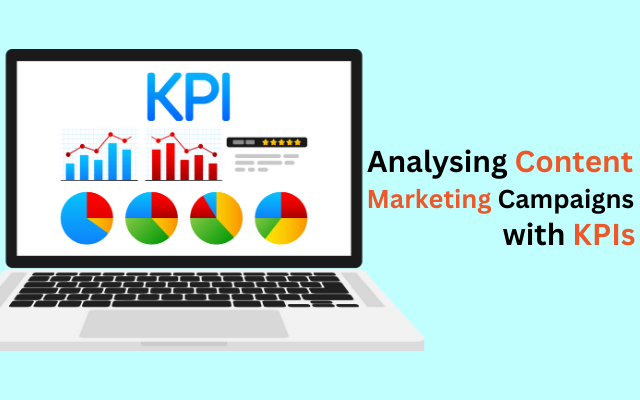
Key Performance Indicators or KPIs are quantifiable values that tell you whether you’re on the right path to achieve your business goals. All types of businesses analyze or measure multiply KPIs to judge the success of various marketing activities.
Content marketing KPIs help measure the effectiveness of your content marketing efforts or activities so that you can make any required changes in time. This ensures businesses meet their goals in an affordable and timely manner. Hence, make sure to choose easily measurable, simple, and relevant KPIs to track the campaign performance across different sales funnels.
But at this point, you might be wondering whether KPIs are any different from marketing metrics in general. Know that KPIs for a particular business are mostly related to engagement, conversions, and awareness and reflect the profitability of the business at any point in time. As for other performance measures, they are useful but aren’t key indicators of business performance.
Delving deeper, here’s what makes KPIs for essential for any content marketing campaign:
- They help identify the most profitable channels for distribution
- KPIs measure both the current and past performances to improve content quality and content distribution strategies.
- They provide critical information for data-driven, intelligent decision-making.
- You can analyses and report real-time data through KPIs easily by using custom dashboards and analytics tools.
- KPIs are the main way marketers can show the impact of advertising and marketing on business growth.
Related – What is Content Distribution and their Strategies?
Conclusion
In a nutshell, content marketing provides you with ample opportunities to woo your target audience, that too at minimal cost. All you need to do is follow the best marketing practices while leveraging a suitable content format.
Notably, the latter would depend on the business goals you’ve set for the near future, your budget, the niche you’re focusing on, and the target audience. Here’s one last tip we’d like to share with you- the initial numbers (KPIs and other metrics) will grow with time, and merely indicate the potential of your brand.
We’ll be back soon with another guide. Till then, take care! So, don’t delay crafting.
Additional Resources:
- Avoid These Multilingual Content Marketing Mistakes To Maximize ROI
- All You Need to Know About a Content Distribution Strategy in 2023
- Evergreen Content Types to Build Lasting Success
- 10 Tips To Boost Your Writing Skills


